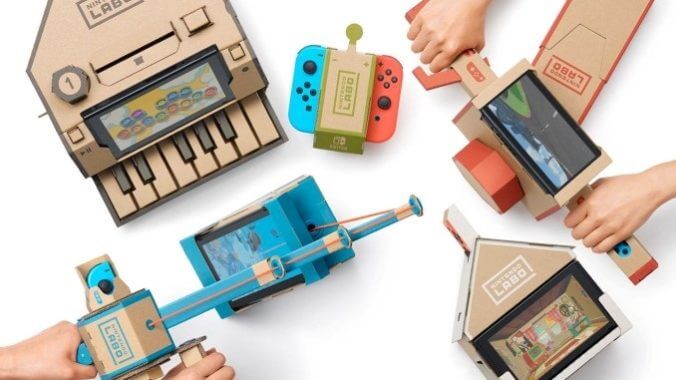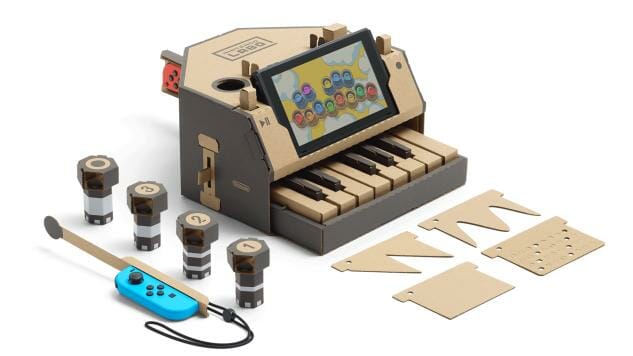We Were Never (Card)Bored with Nintendo Labo
Images courtesy of Nintendo Games Features Nintendo Labo
Since their inception videogames have been tied to technology, with beeps and boops exponentially growing in bit-count to reach the 4K 60FPS standard that we’ve reached today. Videogames are motherboards, and graphics cards, and D-Pads, and CRT-TVs, and high-refresh monitors, and everything electronic. They are also cardboard, or at least can be, according to Nintendo. Five years ago, the Willy Wonka of Games asked confused consumers, upset traditionalists, and intrigued children to come with them into a world of pure imagination made of cardboard, reflective stickers, string, and so much tape with the release of Nintendo Labo.
It seems ridiculous, ill-advised even, that Nintendo chose to capitalize on the runaway success of the Switch by releasing a line of recycled, LEGO-esque edutainment products where a majority of the fun happened off the screen. The Japanese game giant has never been afraid of taking big swings—a VR-system in 1995 that had consumers seeing red, a credit-card swiping peripheral for the GameBoy Advance, stereoscopic 3D that didn’t even require glasses to give you a gnarly headache—but Labo was certainly their most unique. For 70 bucks, players could purchase high quality cardboard, stickers, and some plastic bits and bobs that, once painstakingly assembled, took advantage of the Joy-Con’s IR sensors and HD rumble to create a pseudo-augmented reality experience. It’s as if Nintendo looked back at all the licensed and unlicensed peripherals from the Wii era and decided to let consumers do all the work for them.
When Labo launched on April 20, 2018, curious gamers and excited children alike could get their hands on two distinct variations: the Variety Kit, which included the materials to build a fishing rod, a motorcycle, a miniature house(??), and a small playable synthesizer; and the Robot Kit, which tasked players to build a cardboard backpack and visor to control a, you guessed it, giant robot. (Fun fact: The Robot Kit is based on a canceled Wii U demo titled Project Giant Robot, proving that Nintendo does, in fact, recycle). The modest success spurred Nintendo into releasing a third kit—the Vehicle Kit, which boasted Mario Kart 8 Deluxe compatibility among new creations—and the fourth, and seemingly final, attempt—their answer to Google Cardboard, the VR Kit—launched only a few days shy of Labo’s one year anniversary.
Nintendo has been radio silent since over the past four years, with rumors of the line being discontinued, while former Nintendo of America President Reggie Fils-Aime stated Labo did well but didn’t meet expectations. Most people might not remember the peripheral, thinking of it instead as a weird, cardboard-fueled fever dream, a blip in Nintendo’s recent dominance. But none of this means that Labo was a failure, and it’s time that we stop treating it as such. Nintendo Labo was fun, weird, and unexpected, and in an industry constantly cannibalizing itself over frame rate issues and console specs, that should be celebrated. It might be compressed paper and silly stickers, but it’s all just so charming.

Reviews and discourse about Labo are misleading because the conversations are mainly had by adults, but the launch trailer made it clear the product was intended for kids. Not just children, but the kid within each of us, the child who once experienced the joys of creation while fiddling with LEGO, Hess Trucks, and any other number of toys. There’s an immense satisfaction that comes with following instructions of how to build something beat by beat, and learning how each part works in reality before being allowed into bite-sized fantasies. The technology was ingeniously simple, using the components of the Switch’s Joy-Con (HD rumble, IR sensors, split connectivity) to give cardboard life without the need for complicated circuitry or electronics. Everything you build has a use—the fishing pole can reel in fish, the motorcycle can drive, the robot can defend the world, and the piano can play some pretty sick tunes.
If you wanted to be creative though, you could always venture into the “Discover” section of the “Make. Play. Discover.” tagline with the Toy-Con Garage, a simple node-based coding program that encouraged the next generation of designers to tinker with complex computer science in a fun, stress-free setting to make their own creations. These basic “if-then” statements allow for endless possibilities, such as reprogramming one Labo to control another as Bill Nye does. Or, it could be used to create your own entirely new games, interactive statues, solar-powered accordions, and more. The only difference between official Labo designs and fan ones was the price you paid for the cardboard, the material itself so readily available that creation was always just one Amazon package away.
The Toy-Con Piano in particular blew well beyond expectations through its sheer versatility. There was a brief time in 2018 when it was nearly impossible to scroll through YouTube without seeing someone tickling the cardboard ivories. People recreated the Mii Channel Theme, made a magnificent Mario medley, and even 3D printed their own soundscapes. All you were limited by was your creativity.
While it may have seemed like Nintendo was asking you to shell out money for fancy cardboard, that’s not all they were giving you with each kit. They were providing the chance to be let loose from the maladies of life, the restrictions of reality, and be a child on the playground again. To create freely and without judgment, providing just enough guidance to make the experience worthwhile and just enough tools to craft your own toys whenever the inspiration strikes. Labo wasn’t perfect, but none of the main criticisms—the tensile strength of the cardboard, the seemingly obscene price-tag, the simplistic games, and the outlandish nature of the product itself—could match that wonder, which has always been Nintendo’s stock-in-trade.
Labo is emblematic of the sheer silliness and creativity that defines Nintendo, something that we haven’t seen much in the five years since its launch. It almost feels as if it’s from a by-gone era, an entirely inclusive and bizarre idea designed by the underdogs who believed that the most important aspect of videogames isn’t the technology, but that you have fun. And if nothing else, Nintendo Labo sure was a bushel of cardboard fun.
Mik Deitz is a freelance writer and former Paste intern. They inhale stories in videogames, films, TV and books, and have never finished God of War (2018). Yell at or compliment them on Twitter @dietdeitz.